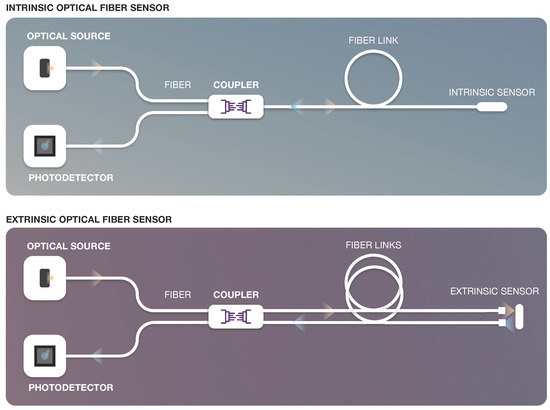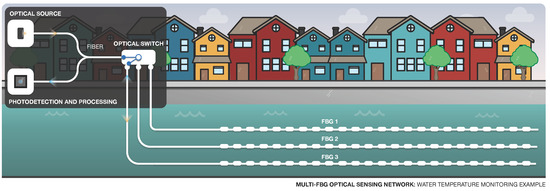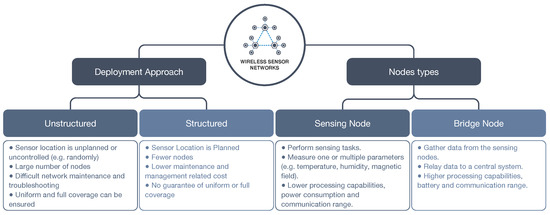Optical fiber sensors present several advantages in relation to other types of sensors. These advantages are essentially related to the optical fiber properties, i.e., small, lightweight, resistant to high temperatures and pressure, electromagnetically passive, among others. Sensing is achieved by exploring the properties of light to obtain measurements of parameters, such as temperature, strain, or angular velocity. In addition, optical fiber sensors can be used to form an Optical Fiber Sensing Network (OFSN) allowing manufacturers to create versatile monitoring solutions with several applications, e.g., periodic monitoring along extensive distances (kilometers), in extreme or hazardous environments, inside structures and engines, in clothes, and for health monitoring and assistance.
- optical fiber sensors
- optical fiber sensing
- optical fiber sensing networks
- sensor networks
- wireless sensor networks
1. Introduction
2. Optical Fiber Sensors
An optical fiber is a cylindrical dielectric waveguide, where both the core and the cladding are composed of glass or plastic, and the surrounding coatings used to protect the optical fiber are made of acrylate or polyimide materials. Optical fibers can be multi-mode or single-mode. An optical fiber sensor expands or contracts according to strains or temperature variations. When light is sent down the fiber to the sensor, it is modulated according to the amount of expansion or contraction. Subsequently, the sensor reflects back an optical signal to an analytical device, which translates the reflected light into numerical measurements of the change in the sensor length. These measurements indicate the level of strain or the temperature [11]. As mentioned before, optical fiber sensors have several advantages relative to other sensor technologies for a variety of applications with extensive potential in sensing applications. Some advantages of optical fibers with regard to sensing include their small size, no requirement of electrical power at the remote location, and many sensors can be multiplexed along the length of the fiber by using light wavelength shift for each sensor, or by sensing the time delay as light passes along the fiber through each sensor [20]. Because optical fiber sensors are immune to electromagnetic interference and do not conduct electricity, they can be used in hazardous environments where high-voltage electricity or flammable material such as jet fuel may be present. Optical fiber sensors can also be designed to resist high temperatures [12]. For these reasons, the application environments range from dangerous scenarios where there are radioactive, chemical, and other industrial-based hazards to more common and simple uses. However, the development of certain types of optical fiber sensors, for example, in corrosion detection, remain in its infancy [11][23][11,23]. In the literature, optical fiber sensors can be classified or categorized considering different aspects. These sensors are frequently grouped according to the sensor location in the fiber, and the operating principle or the application [24][25][26][27][24,25,26,27]. When considering matters of application, optical sensors can be categorized considering the type of parameters they are intended to measure, namely: physical (e.g., strain, temperature), chemical (e.g., oil parameters, pH, ammonia, detergents, pesticides and humidity) [28][29][28,29] or bio-medical (e.g., oxygen, carbon dioxide, proteins, cells, proteins, and DNA) [29][30][31][32][33][29,30,31,32,33]. Concerning the sensor location, the optical sensor can be classified as intrinsic or extrinsic [22] (Figure 1).

-
Intensity-modulated sensors were among the first optical fiber sensors to be developed [26]. These sensors can detect physical changes or perturbations in the received light (bend loss, attenuation, evanescent fields). Simplicity and lower costs present the advantages of this optical sensor type; however, these sensors are susceptible to fluctuations in optical power loss leading to false readings, and therefore requiring a reference system to minimize the problem.
-
Wavelength-modulated sensors measure the wavelength change in the fiber. Examples of wavelength-modulated sensors include black body sensors, fluorescence sensors, and the Bragg grating wavelength-modulated sensors. The FBG sensor represents the most popular type of wavelength-modulated sensor and is frequently used in different applications since it is capable of single-point or multi-point sensing.
-
Phase-modulated sensors use the interferometry principle to measure interference of the optical fiber light. These sensors are popular owing to their high sensitivity and accuracy; however, this also translates to a higher cost. The most popular phase-modulated sensors include the Mach–Zehnder, Sagnac, Michelson, and Fabry–Perot interferometers.
-
Scattering-based sensors use an Optical Time Domain Reflectometer (OTDR) to detect changes in the scattered light. These sensors are very popular since they enable distributed sensing along the length of the fiber with interesting applications in structural health monitoring, and measuring changes in strain.
-
Polarization-based sensors detect changes in the light caused by an alteration in the polarization state. These sensors exploit the birefringence phenomenon in the optical fiber, where depending on the polarization the refractive index changes. When applying strain to the optical fiber, the birefringence effect occurs and results in a detectable phase difference.
3. Optical Fiber Sensing Networks
In many applications, it is desirable or even imperative to measure strain and temperature at multiple locations at the same time. Wireless sensors emerged to solve some of the difficulties. However, the power supply required for continuous operation and the inability to scale in large scenarios present some of their associated disadvantages. These and other issues are overcome by Optical Fiber Sensing Networks (OFSNs), which offer the possibility to support a large number of sensors in a single optical fiber with long unamplified transmission ranges, high bandwidth, low power loss, and enhanced data privacy. In addition to the single-point sensing, OFSNs can be distributed or multi-point.3.1. Multiplexing Techniques
In applications where the goal is to simultaneously monitor data from several sensors in a network, it is challenging to process this information simultaneously. Multiplexing solves this problem by combining signals from several sensors into one signal transmitted over the same medium, which is the optical fiber. Information can be multiplexed in several ways, depending mostly on the network topology (defines how sensors are connected in the network) and on sensor addressing (used to distinguish information from each sensor in the network). This can be achieved considering different domains, such as the time, frequency, or wavelength. Ideally, there is a set of criteria that a multiplexing system should satisfy [47][84]: no restrictions regarding the type and properties of the sensors; scalability to increase the number of sensors in the network without penalizing its structure; ability to integrate sensors with high dynamic range; low interference (crosstalk) between sensors. Ultimately, multiplexing optical fiber sensors minimizes system costs since it allows for reductions in the optical sources, detectors, modulators, and other components necessary to support the sensing network [47][84].3.2. Distributed Sensing
The principle behind distributed sensing is the scattering of light that propagates in the fiber core, in particular, the backscattering to allow the propagation of the scattered light back to the detection unit. As previously explained in Section 2.3, optical time domain reflectometry is used in distributed sensing to determine the location of variations along the length of the fiber. A Raman-OTDR is used for distributed temperature measurements and a Brillouin-OTDR is used for distributed strain or temperature measurements. Sensing systems based on Brillouin and Raman scattering are used to detect the localized strain and temperature, allowing the monitoring of hundreds of kilometers along a structure with a single instrument, and with an accuracy of around 1 m [11][48][11,97]. The ability to measure temperatures and strains at thousands of points along a single fiber is particularly interesting for monitoring large structures [11][49][11,98] such as dams, tunnels, pipelines, bridges, and landslides, where it allows the detection and localization of movement, leakage, deflection, and seepage zones, with sensitivity and localization accuracy unattainable using conventional measurement techniques [6]. Figure 3 illustrates an application scenario for distributed sensing, where a continuous-sensing fiber element is used to monitor parameters such as strain or temperature in a tunnel.
3.3. Multi-Point Sensing
Multi-point sensing detects variations only in the vicinity of localized sensors. Measurements performed in discrete points that can be located along a large area covered by an OFSN are considered multi-point sensing with multiplexed point sensors. Multiplexing involves the concepts of network topology, sensor addressing, and sensor interrogation. The first is related to the sensors’ arrangement in a network, which may have consequences in terms of power budget and sensor crosstalk. The second involves the study of processes and techniques that permit the addressing of a particular sensor from the emission and detection block, taking into consideration that typically all sensors are related to time, wavelength, coherence, frequency, or spatial addressing. The third is associated with the process to read the status of a specific sensor and obtaining measurand information. In multi-point sensing, there are multiple types of topologies: serial, parallel, and ladder [51][52][99,100]. The serial topology consists of an optical source, a modulator, a sensor array, and to recover the signal, a demodulator, and finally, the optical detector. Sensors can be reflective or transmissive, which means that different configurations influence the way the signal is redirected to the detector array. A reflective sensor reflects the light in direction of the detector and a transmissive sensor redirects the signal to the detector. The parallel topology is the simplest arrangement and consists of an optical source (which can be more than one source) that is coupled into the fiber network, and the power is distributed via a multiple-port directional coupler into a set of parallel downleads. The signal travels through each downlead that contains a sensor and is then redirected to the detector array. FBG networks (Figure 4) are one of the most well-known examples of multi-point sensing. FBGs are widely used owing to their many advantages already described before, such as multiplexing capability and wavelength-encoded information, and eliminating power variations [53][54][55][86,101,102]. FBGs can measure the strain and temperature separately [11].

3.4. OFSN Applications
As previously discussed, since the optical fiber is made of non-metal material, it is more resistant to environmental factors and can be used in severe conditions such as high/low temperature and humidity. In addition, it is immune to electric and electromagnetic interference as well as signal errors in the transmitting process. Therefore, OFSNs have been used in several fields for monitoring different parameters. The dual functionality of the fiber (simultaneously sensing element and communication channel) with low limitations (distance versus bandwidth) enables the implementation of an extensive sensor network. Hybrid approaches based on optical fiber sensing combined with out-body wireless communication are also interesting in this domain [18]. This section presents a summary of applications of optical fiber sensor networks in different fields, specifically considering multi-point and distributed sensing. In several applications, a combination of distributed and multi-point sensing can be used, e.g., in healthcare sensing systems [18]. Examples of single-point sensing were already provided for each type of optical fiber sensor in Section 2. The lifespan of the infrastructure is long, ranging from several decades to over one hundred years. Depending on the type of structure, a range of parameters such as strain, temperature, corrosion and thickness reduction, leakage acoustics, and pressure may be important to quantify. Despite the existence of several methods to detect damage in civil infrastructure [59][110], most of them suffer from various disadvantages such as lack of portability, susceptibility to electromagnetic interference, and lack of capability for continuous and remote monitoring over large distances. In 1989, optical fiber sensors were introduced as concrete structural monitors [12] and became a very important element in civil infrastructures, such as bridges or pipelines [11]. Subsequently, many research groups started to implement optical fiber sensors in various structures [9][12][18][9,12,18]. Optical fiber strain sensors have shown to be the best option for long-term health monitoring of concrete bridges due to their small size, light weight, immunity to electromagnetic disturbance, resistance to harsh environments, ability to be embedded internally, and multiplexing capabilities. These sensors have been used for measuring strain in large concrete and steel structures [15][57][60][15,54,111], for health monitoring in composite structures [61][112] and railways [62][113], for monitoring structural fires [63][114], and for strain/displacement monitoring of geotechnical structures (dams, slopes, tunnels, or excavation engineering) [64][115]. In addition, OFSNs are capable of long-distance transmissions, hence they are better suited for remote strain monitoring than any other strain sensing technique [12]. FBGs with multi-point sensing network configuration were used to create seismic maps of the sea floor, and these maps are used today for monitoring oil and gas reservoirs [65][116]. This is achieved by analyzing the propagation of seismic waves induced by controlled explosions. Interferometric optical fiber sensing systems were used to sense the seismic waves and may require over 30,000 sensors, using a specific combination of time and wavelength multiplexing [18]. OFSNs provide sensing solutions for almost all application types and in inflammable, radioactive, or chemically corrosive environments, owing to the intrinsic characteristics of the optical fiber [18][66][67][18,117,118]. In the following, a few additional applications are listed:-
Healthcare: Heart rate and respiratory rate sensors based on FBGs perform multi-point sensing in [74][62]. A review of fiber optic sensors for sub-centimeter spatially resolved measurements [75][124] presented applications of these sensors in many areas, such as thermotherapy, catheterization for diagnostic purposes through gastroscopy, urology diagnostics, and smart textiles.
4. Wireless Sensor Networks
With the development and proliferation of Micro-Electro-Mechanical Systems (MEMS) technology, which enables the development of smart sensors, WSNs have attracted worldwide attention [76][77][78][79][125,126,127,128]. These sensors can be designed to measure different parameters (e.g., mechanical, thermal, biological, chemical or magnetic) and can be small and low power. Integrating wireless communications capabilities with these sensors allows for the creation of low-cost nodes that are able to acquire and transmit data. Due to these features, WSNSs provide a flexible and efficient approach for multi-point sensing, allowing large-scale real-time monitoring and data collection and at a lower cost. In a WSN, sensor nodes work together to monitor several parameters about the environment, usually without an infrastructure. Considering the deployment approach, a WSN can be classified as unstructured or structured [76][125] (Figure 6). An unstructured WSN contains a large number of sensor nodes that can be deployed randomly (in an ad hoc manner), increasing the complexity and costs related to network maintenance (e.g., node troubleshooting). In addition, since the locations of the nodes are not specified, uniform or full coverage of an area cannot be guaranteed. In a structured WSN, the sensor nodes’ locations are planned and plotted. Therefore, uniform and full coverage can be ensured and fewer nodes can be deployed, resulting in lower costs for network maintenance. However, the structured deployment can be complex in certain applications and lead to more effort and costs in the deployment stage.
4.1. Integration with Optical Fiber Sensors
Integration with Optical Fiber Sensors
As mentioned before, MEMS sensors have some limitations in terms of measurement capabilities, when compared to optical fiber sensors, due to the limited types of sensing mechanisms built into the MEMS sensor design. On the other hand, optical fiber sensor systems are often used alone in pre-defined positions, and therefore extensive lengths of optical fiber cable are necessary for connecting all the sensors as an optical fiber network. Additionally, in many circumstances dealing with this cabling can be a problem. Despite the distinct advantages of WSNs and optical fiber sensors, and the constant developments in both areas, the integration of these two technologies is not a common occurrence. The reason behind this is possibly related to the complexity of optical fiber sensors in comparison to other sensors, and the relatively low cost and low power consumption of other solutions. However, these “hybrid” sensing networks may be very important in applications where harnessing the advantages of both optical fiber sensors and WSNs is crucial [80][129]. There is some research focused on the integration of WSNs with optical fiber sensors [22][81][82][22,130,131], aiming to obtain the best of both worlds, namely the advantages related to the optical fiber sensors and the means of communication provided by WSNs. Figure 7 represents a possible application of a solution that integrates optical sensing with a WSN. In the depicted case, a distributed optical sensing network is used to monitor each wind turbine in an offshore wind farm. The parameters that can be monitored include underwater structure bend, corrosion, water temperature, salinity, and so forth [83][132]. Moreover, optical fibers can be used to monitor blade parameters [84][133], such as the bend or strain, that influence the performance of the wind turbine. In addition to the immunity to electromagnetic effects, another advantage is that optical fibers are ideal for performing this type of monitoring because it is flexible and light, and can even be integrated in to the blade material [85][134].
